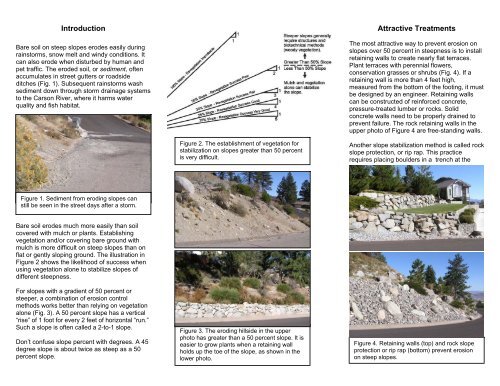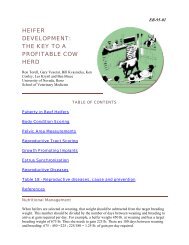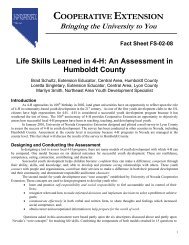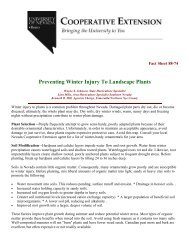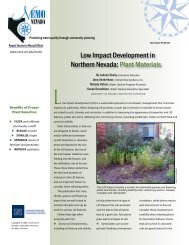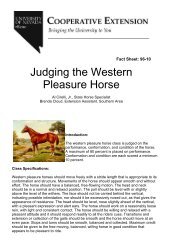Stabilize Steep Slopes with Plants and Erosion Control Structures
Stabilize Steep Slopes with Plants and Erosion Control Structures
Stabilize Steep Slopes with Plants and Erosion Control Structures
You also want an ePaper? Increase the reach of your titles
YUMPU automatically turns print PDFs into web optimized ePapers that Google loves.
Introduction<br />
Bare soil on steep slopes erodes easily during<br />
rainstorms, snow melt <strong>and</strong> windy conditions. It<br />
can also erode when disturbed by human <strong>and</strong><br />
pet traffic. The eroded soil, or sediment, often<br />
accumulates in street gutters or roadside<br />
ditches (Fig. 1). Subsequent rainstorms wash<br />
sediment down through storm drainage systems<br />
to the Carson River, where it harms water<br />
quality <strong>and</strong> fish habitat.<br />
Attractive Treatments<br />
The most attractive way to prevent erosion on<br />
slopes over 50 percent in steepness is to install<br />
retaining walls to create nearly flat terraces.<br />
Plant terraces <strong>with</strong> perennial flowers,<br />
conservation grasses or shrubs (Fig. 4). If a<br />
retaining wall is more than 4 feet high,<br />
measured from the bottom of the footing, it must<br />
be designed by an engineer. Retaining walls<br />
can be constructed of reinforced concrete,<br />
pressure-treated lumber or rocks. Solid<br />
concrete walls need to be properly drained to<br />
prevent failure. The rock retaining walls in the<br />
upper photo of Figure 4 are free-st<strong>and</strong>ing walls.<br />
Figure 2. The establishment of vegetation for<br />
stabilization on slopes greater than 50 percent<br />
is very difficult.<br />
Another slope stabilization method is called rock<br />
slope protection, or rip rap. This practice<br />
requires placing boulders in a trench at the<br />
Figure 1. Sediment from eroding slopes can<br />
still be seen in the street days after a storm.<br />
Bare soil erodes much more easily than soil<br />
covered <strong>with</strong> mulch or plants. Establishing<br />
vegetation <strong>and</strong>/or covering bare ground <strong>with</strong><br />
mulch is more difficult on steep slopes than on<br />
flat or gently sloping ground. The illustration in<br />
Figure 2 shows the likelihood of success when<br />
using vegetation alone to stabilize slopes of<br />
different steepness.<br />
For slopes <strong>with</strong> a gradient of 50 percent or<br />
steeper, a combination of erosion control<br />
methods works better than relying on vegetation<br />
alone (Fig. 3). A 50 percent slope has a vertical<br />
“rise” of 1 foot for every 2 feet of horizontal “run.”<br />
Such a slope is often called a 2-to-1 slope.<br />
Don’t confuse slope percent <strong>with</strong> degrees. A 45<br />
degree slope is about twice as steep as a 50<br />
percent slope.<br />
Figure 3. The eroding hillside in the upper<br />
photo has greater than a 50 percent slope. It is<br />
easier to grow plants when a retaining wall<br />
holds up the toe of the slope, as shown in the<br />
lower photo.<br />
Figure 4. Retaining walls (top) <strong>and</strong> rock slope<br />
protection or rip rap (bottom) prevent erosion<br />
on steep slopes.


